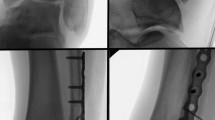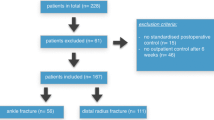Abstract
Purpose
To determine the interobserver reliability of syndesmosis assessment using intraoperative ankle mortise fluoroscopic images, with and without contralateral images.
Methods
A survey of 19 operative ankle fracture cases was administered to 17 orthopedic surgeons. Respondents were presented with fluoroscopic mortise and stress images of the ankle after fracture fixation and asked if they would fix the syndesmosis. Final fluoroscopic mortise images were then shown, and respondents were asked to assess the reduction of the syndesmosis. Six weeks later, the survey was administered again with the addition of contralateral fluoroscopic ankle mortise images. Responses were compared to a standard response agreed upon by fellowship-trained orthopedic trauma surgeons.
Results
Interobserver reliability for syndesmosis fixation and reduction, with and without contralateral images, was considered weak (kappa 0.48 and 0.43; mean difference 0.05, 95% confidence interval (CI) 0.01 to 0.1) and minimal (kappa 0.25 and 0.22; mean difference 0.02, CI − 0.02 to 0.08). With the addition of contralateral mortise images, the number of surgeons who changed their response for syndesmosis fixation and reduction quality ranged from 0% to 41% and 0% to 88%; with the number of responses matching the standard increasing for both fixation (proportional difference (PD) 7%, CI 1% to 14%) and reduction (PD 14%, CI 7% to 21%);
Conclusions
Interobserver reliability of syndesmosis fixation and reduction remained weak to minimal between surgeons, with and without contralateral images. Future studies are necessary to understand the variability in surgeon responses in order to improve the intraoperative assessment and fixation of syndesmotic injuries.



Similar content being viewed by others
References
Sagi HC, Shah AR, Sanders RW (2012) The functional consequence of syndesmotic joint malreduction at a minimum 2-year follow-up. J Orthop Trauma 26:439–443. https://doi.org/10.1097/BOT.0b013e31822a526a
Andersen MR, Diep LM, Frihagen F et al (2019) Importance of syndesmotic reduction on clinical outcome after syndesmosis injuries. J Orthop Trauma 33:397–403. https://doi.org/10.1097/BOT.0000000000001485
Warner SJ, Fabricant PD, Garner MR et al (2014) The measurement and clinical importance of syndesmotic reduction after operative fixation of rotational ankle fractures. J Bone Jt Surg Am 97:1935–1944. https://doi.org/10.2106/JBJS.O.00016
Chu X, Salameh M, Byun S-E et al (2021) The utilization of intraoperative contralateral ankle images for syndesmotic reduction. Eur J Orthop Surg Traumatol. https://doi.org/10.1007/s00590-021-02984-4
Anand Prakash DA (2018) Syndesmotic stability: Is there a radiological normal?—A systematic review. Foot Ankle Surg 24:174–184
Boszczyk A, Kwapisz S, Krümmel M et al (2018) Correlation of incisura anatomy with syndesmotic malreduction. Foot Ankle Int 39:369–375. https://doi.org/10.1177/1071100717744332
Coles CP, Tornetta P, Obremskey WT et al (2019) Ankle fractures. J Orthop Trauma 33:e318–e324. https://doi.org/10.1097/BOT.0000000000001503
Summers HD, Sinclair MK, Stover MD (2013) A reliable method for intraoperative evaluation of syndesmotic reduction. J Orthop Trauma 27:196–200. https://doi.org/10.1097/BOT.0b013e3182694766
McHugh ML (2012) Interrater reliability The kappa statistic. Biochem Medica 22: 276–282. https://doi.org/10.11613/bm.2012.031
Meinberg EG, Agel J, Roberts CS et al (2018) Fracture and dislocation classification compendium-2018. J Orthop Trauma 32(Suppl 1):S1–S170. https://doi.org/10.1097/BOT.0000000000001063
Weening B, Bhandari M (2005) Predictors of functional outcome following transsyndesmotic screw fixation of ankle fractures. J Orthop Trauma 19:102–108. https://doi.org/10.1097/00005131-200502000-00006
Gardner MJ, Demetrakopoulos D, Briggs SM et al (2006) Malreduction of the tibiofibular syndesmosis in ankle fractures. Foot Ankle Int 27:788–792. https://doi.org/10.1177/107110070602701005
Koenig SJ, Tornetta P, Merlin G et al (2015) Can we tell if the syndesmosis is reduced using fluoroscopy? J Orthop Trauma 29:e326–e330. https://doi.org/10.1097/BOT.0000000000000296
Funding
This research did not receive any specific grant from funding agencies in the public, commercial, or not-for-profit sectors.
Author information
Authors and Affiliations
Corresponding author
Ethics declarations
Conflict of interest
None of the authors have financial conflicts of interest relevant to the content of this study.
Ethical approval
All procedures performed in studies involving human participants were in accordance with the ethical standards of the institutional and/or national research committee and with the 1964 Helsinki declaration and its later amendments or comparable ethical standards.
Informed consent
The institutional review board approved this study. Due to the retrospective nature of this work, informed consent was waived.
Additional information
Publisher's Note
Springer Nature remains neutral with regard to jurisdictional claims in published maps and institutional affiliations.
Rights and permissions
About this article
Cite this article
Salameh, M., Byun, SE., Chu, X. et al. Need for syndesmotic fixation and assessment of reduction during ankle fracture fixation, with and without contralateral fluoroscopic images, has poor interobserver reliability. Eur J Orthop Surg Traumatol 32, 1089–1095 (2022). https://doi.org/10.1007/s00590-021-03084-z
Received:
Accepted:
Published:
Issue Date:
DOI: https://doi.org/10.1007/s00590-021-03084-z




